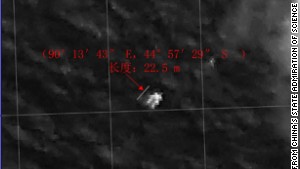That Colossal Search
"Objects that have drifted for two weeks will have travelled a long way in that time. If you have currents at four knots, that means four nautical miles per day and a considerable distance in 14 days."
"After you have identified and examined some debris, you can piece together how the plane broke up. Was it in the air, was it during a sea landing, or did it hit the ocean surface? From that you can build up a scenario."
Captain of the Hoegh, St.Petersburg, Norwegian cargo vessel

Scanning the seas: A Royal Australian Air Force
AP-3C Orion plane passes over the Norwegian car transport ship Hoegh St
Petersburg during the search for the missing flight MH370
To speak, however theoretically -- and at the same instance, the most intelligently experienced theorizing -- of an airplane carrying 239 men, women and children disintegrating over a vast ocean with all lives most assuredly lost, is to give no comfort to the distraught families of those who were passengers or crew on Malaysia Airlines Flight MH370.Who, in their agony, would far prefer to visualize their loved ones patiently awaiting rescue from the landing the plane took under duress on a remote archipelago in a vast oceanic landscape, which rescuers have not yet discerned to be the resting place of that errant airliner. Their relatives will be exhausted, frightened, hungry and miserable, and perhaps some will be in need of emergency medical treatment, but they will be alive.

This is their tenuous, passionately-hoped for reality. One that, when the lost plane is finally discovered on an unused runway overgrown by an encroaching jungle, with those on board eking out their existence on whatever food was left in the plane's pantry, anxious for discovery and grateful that they would soon resume their normal lives. The other reality -- the one that rational minds unencumbered by personal grief hark to -- is to identify the detritus floating on the ocean.
Say, for example, one or more of the ships and aircraft dispatched to one of the remotest places of deep oceanic presence on the planet, roughly 2,500 kilometres southwest of Australia to isolate the "credible sighting" of what might be wreckage of the plane. The world is a large place, and its oceans are vast and unknown to a degree complicated by their very isolated distance.

Flight Lieutenant Neville Dawson (centre)
monitors instruments aboard the Royal Australian Air Force AP-3C Orion
on the second day of an extensive search of the remote reaches of the
southern Indian Ocean

A satellite image released by China shows an object in the southern Indian Ocean. 22 March 2014
There will be no relief, in this lifetime, for the family members of the Malaysian Airlines Flight MH370 from the nightmare their lives have descended into. Two weeks following the disappearance of the plane, there is no reasonable possibility of the fantasized vision of survival.
But the searchers, after expending time, energy, imagination, experience and money in conducting the search among 24 nations taking part, could find closure in any possible discovery of devices that might solve the puzzle of a plane vanishing from a regularly scheduled flight taking with it all those doomed souls.


<< Home